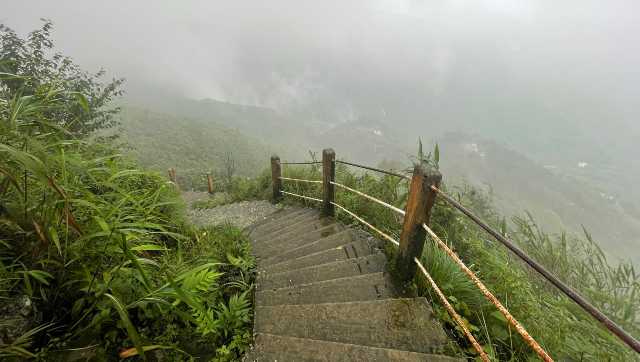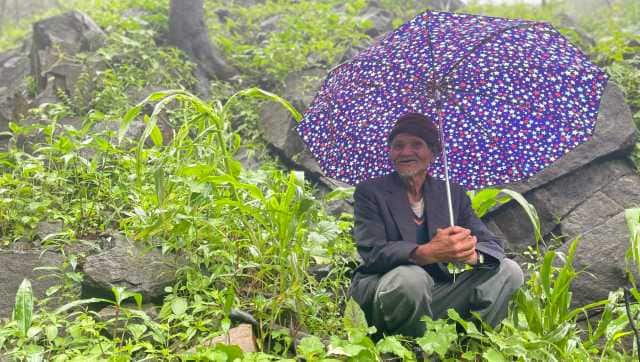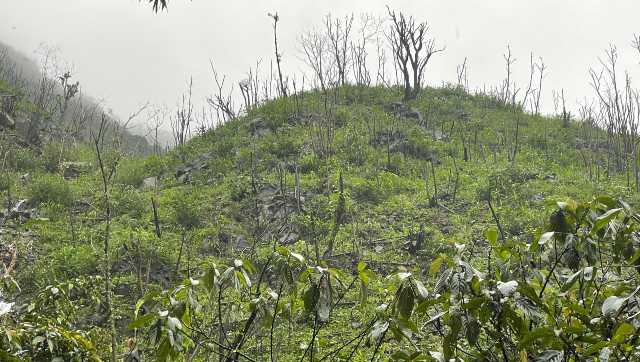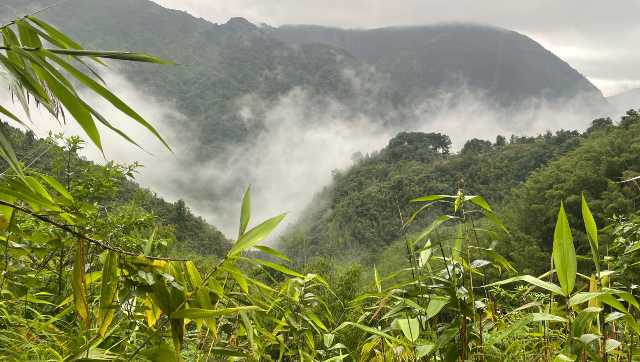Aided by the mist, columns of stinging rain were attacking the green mountains of East Khasi hills. The green giants under pressure, bled from 11 places starting waterfalls that rushed to meet the river. They gave life and serenity to the scenery over Nongtraw, Meghalaya. So what was I doing here? My mission was to know how this community which practices slash and burn agriculture aka Jhoom, has survived for centuries sustainably and healthily without destroying their environment. “Environmentalists” have been scornful towards Jhoom farmers, but I distinguish facts from fiction. So set out 2,600 steps downhill to seek my answers. My guide into the green paradise was Bhogtoram Mawroh, an agrarian researcher and social development worker. [caption id=“attachment_11090021” align=“alignnone” width=“640”]  The steps at Nongtraw in Meghalaya. Image courtesy Indra Shekhar Singh[/caption] As we descended, I noticed very few trees, a rare thing for the mountain side. But even before I shout out ‘community driven deforestation’, Bhogtoram spoke up, “Each inch of soil on these mountains has been planted by this community. Over generations people have planted even the most inclined slopes. We aren’t going down the mountain, but rather entering a food mountain filled with edible herbs and foods.” Mawroh’s statement struck me like thunder in the rain. I remained silent, observing very turn and corner for edible plants and herbs. Occasionally, I would spot a yam or a squash leaf, but this wasn’t even the tip of the food iceberg. After making a drying stop at the community hall in Nongtraw, we followed Pitrius, an elderly farmer into the ‘sash and burn’ fields. As we moved away from the village the forest began to grow dense but our conversation was only beginning. Pitrius moved to Nongtraw after marriage and since has farmed here. He was well-versed with jhoom traditions. “The first step in Jhoom is to identify the land. We lop all the branches take them for fuel wood, and then cut the trees down. We let them dry for a few days, before we set fire to them,” Pitrius explained. After the plot is cleared, the village council allots lands to the villagers, who then farm it for a stipulated period of time. Once the time passes, any member of the village is free to harvest from the plots, as often after farming, wild edibles and herbs start fruiting naturally. Most of the farming is done using native seeds and organic manure. While the men are responsible for ploughing, cutting trees, the women take care of harvests, sowing, etc and lands are also allotted to women and not the men. It also became clear while talking to Pitruis that Jhoom farming uses fire extensively, and communities are very particular about fire management. “Fire-breakers are created before the burning happens. Because one mistake and the whole forest can burn down. And children are initiated into the farming by the elders, it is the children who light the fires,” Pitruis explained. [caption id=“attachment_11090071” align=“alignnone” width=“640”]  Pitruis is an expert in Jhoom cultivation. Image courtesy Indra Shekhar Singh[/caption] “The ash acts as fertilisers for the fields too. But keep in mind we only return to farm again on the same plot after 25 years. Now some communities are returning after 12 years, but it’s vital to leave the land fallow after jhoom. This balance is crucial to maintain a healthy environment,” he said. We were still far from the Jhoom fields and yet our path was surrounded by forest edibles. And the mud trail was held together by roots size of boa snakes. Grasses, shrubs, earthworms and snakes all lived around the path. From the shrubs, Bhogot picked out random leaves and handed them over to me. I quickly munched, it was a wild leafy vegetables and it tasted like “freshness”. Pitrius smiled as it was his favourite vegetable. Here Bhogot began to explain, “These areas have over 87 types of edibles forest foods. They are super nutritious and help ameliorate many medical conditions. It is because of their diet that they suffer less from food style diseases.” Now we have crossed six streams and three bamboo bridges, and for a city person this already was an adventure. One couldn’t stop marvelling at how these people have worked with nature to farm the mountains sustainably as on every available patch of soil there was wild vegetation or it was inter-cropped with at least 8-10 crops – maize, beans, pumpkin, cucumber, herbs, millet, taru (yam ), potato and these are the only edible ones I could identify. But was it always this way? Pitruis had some answers, “Earlier we grew potatoes, wild yam, sweet potatoes and other local edible crops. Most things we grew, we consumed. The men made bamboo baskets and exchanged them for salt and cooking oil in the market. But today there are a lot of broomstick plants, and our community is also commercially selling it. Pig farming has also gone down.” It was visibly clear that broom sticks plants had overcrowded the mountain face and in the future could become an biodiversity risk. We had walked a long way, and finally the lopped trees were visible. But the path ahead had broken off. Our next bamboo bridge was destroyed by the monsoon streams. But rains were destroying more than bridges. “Instead of April the rains have started since late February. Rain is now excessive and unpredictable. It rained in March but it was light rain. Now it’s heavy rainfall which is damaging crops and washing off minerals from the soil and also affecting growing cycles because if it rains, we can’t burn plots,” Pitruis added. Having seen enough rain and Jhoom fields we turned back to the village where fresh pork, wild edibles and rice awaited us. After lunch, I sat with Bibiana Rani who has been practising Jhoom for the last 40 years. From millets, yam, sweet potato and tapioca, Bibiana grows over 40 edibles on her patch of land. As women are in charge here, from land titles to local administration, I wanted to understand how it all happens. “The food forest has sustained us and we work to maintain the forest. It’s a symbiotic relationship. We also don’t use chemicals or pesticides. At best we use manure, but that too rarely, as the ash fertilises the soils. Now as for the land ownership, we get one plot of land to farm for four years, after this time we have to return the land to the village council. There is no permanent land ownership here,” Bibiana said. It started to pour again, and we ran to shelter under the blue church. I wanted to know more about this collective ownership of land. “Each time a villager requests for land two members of the council survey the land and then allot the land. And every member has equal right to the land and has to pay the village council the same tax. We have a fair system with no kings or big landlords. We all work equally,” Bibiana said. [caption id=“attachment_11090081” align=“alignnone” width=“640”]  Sustainable farming in Meghalaya. Image courtesy Indra Shekhar Singh[/caption] Interestingly the village had a headman, but all land titles and other powers were vested with the women in this matrilineal village. The headman or any man could not have land titles to their name. Rather a smart way of preventing misuse of power and separating the political and economic. Only recently women have been allowed to play a role in the political space. Bibiana herself was one of the first members of village council. The times were changing in Nongtraw, from political to climatic. But the Jhoom system was still going strong, apart from being ecological it is agro-biodiverse and also quiet egalitarian. I had never seen such a model of agriculture churning out nutrition and agro-justice at the same time. My day at Nongtraw was over and by 3 pm I was on 2335 step up. But the rain hadn’t stopped, half drenched and musty, I looked one last time at Nongtraw, questioning myself why can’t we all produce food a sustainable way? This is part 2 of a three-part series. Click here for Part 1 . The writer is an independent agri-policy analyst and the former director, Policy and Outreach, National Seed Association of India. Read all the Latest News , Trending News , Cricket News , Bollywood News , India News and Entertainment News here. Follow us on Facebook, Twitter and Instagram.
The times were changing in Nongtraw from political to climatic but Jhoom cultivation has ensured a model of agriculture churning out nutrition and agro-justice at the same time
Advertisement
End of Article


)
)
)
)
)
)
)
)
)



